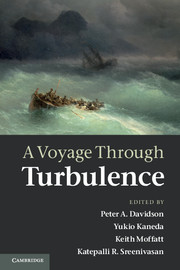Book contents
- Frontmatter
- Contents
- List of contributors
- Preface
- 1 Osborne Reynolds: a turbulent life
- 2 Prandtl and the Göttingen school
- 3 Theodore von Kármán
- 4 G.I. Taylor: the inspiration behind the Cambridge school
- 5 Lewis Fry Richardson
- 6 The Russian school
- 7 Stanley Corrsin
- 8 George Batchelor: the post-war renaissance of research in turbulence
- 9 A.A. Townsend
- 10 Robert H. Kraichnan
- 11 Satish Dhawan
- 12 Philip G. Saffman
- 13 Epilogue: a turbulence timeline
- References
11 - Satish Dhawan
Published online by Cambridge University Press: 07 October 2011
- Frontmatter
- Contents
- List of contributors
- Preface
- 1 Osborne Reynolds: a turbulent life
- 2 Prandtl and the Göttingen school
- 3 Theodore von Kármán
- 4 G.I. Taylor: the inspiration behind the Cambridge school
- 5 Lewis Fry Richardson
- 6 The Russian school
- 7 Stanley Corrsin
- 8 George Batchelor: the post-war renaissance of research in turbulence
- 9 A.A. Townsend
- 10 Robert H. Kraichnan
- 11 Satish Dhawan
- 12 Philip G. Saffman
- 13 Epilogue: a turbulence timeline
- References
Summary
Introduction
Satish Dhawan was born on 25 September 1920 in Srinagar, Kashmir, the home town of his mother Lakshmi. His father, Devidayal, was from the North Western Frontier Province; both parents came from professional families, full of doctors, lawyers and academics – Devidayal retired as a respected judge of the High Court in Lahore, now in Pakistan. Satish's education began under private tutors at home, as his father kept getting transferred in his early career from one town to another in the North West (Kipling country to Indo-British readers). He completed his Indian education at the University of Punjab in Lahore with an unusual combination of degrees: BA in physics and mathematics (1938), MA in English literature (1941) and BE (Hons.) in mechanical engineering (1945). In 1946 he sailed to the USA on a government scholarship, and obtained an MS in aeronautical engineering from the University of Minnesota the following year. (The summer of 1947 saw much turmoil in the subcontinent preceding its imminent partition, and Satish's parents reluctantly left Lahore for India – never to return – a week before the formal end of colonial rule.) In the USA Satish moved to the California Institute of Technology where, with Hans W. Liepmann as his adviser, he obtained the degree of Aeronautical Engineer in 1949 and a PhD in aeronautics and mathematics in 1951. Dhawan made a strong impression, scientifically and otherwise, on everybody he came in contact with at Caltech.
- Type
- Chapter
- Information
- A Voyage Through Turbulence , pp. 373 - 392Publisher: Cambridge University PressPrint publication year: 2011



